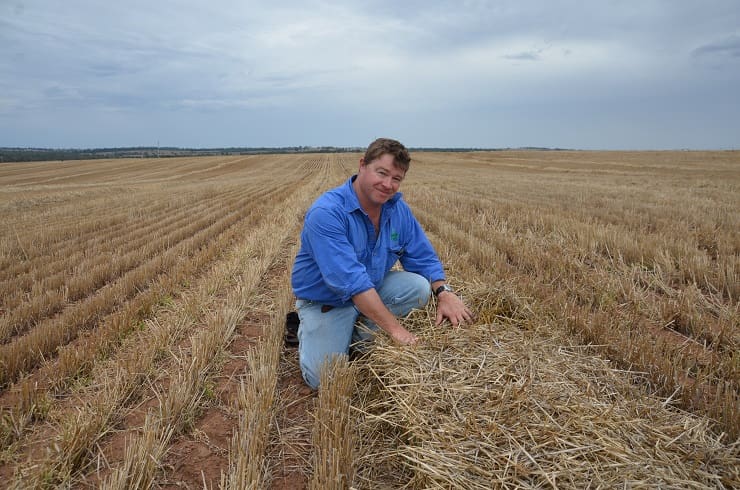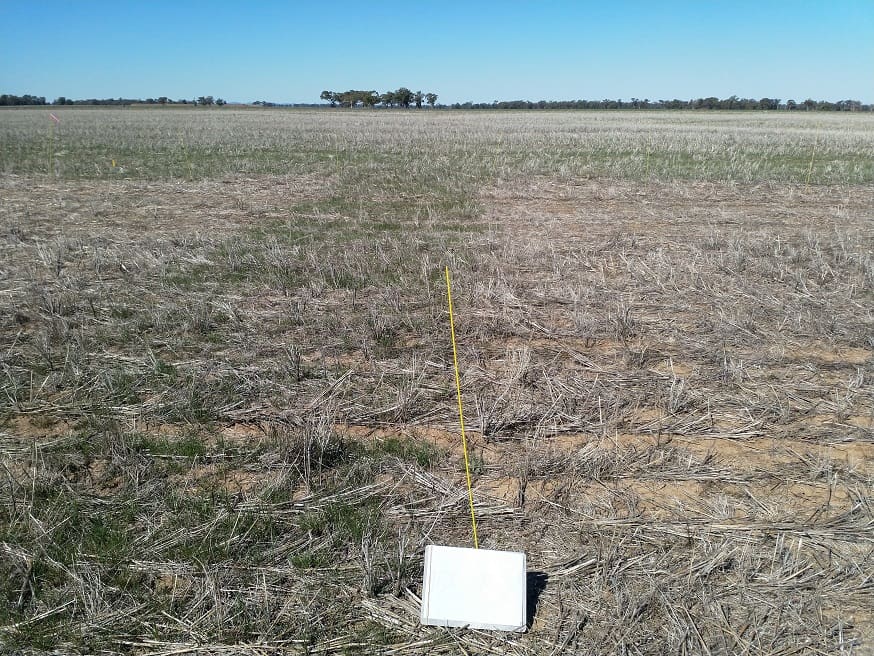
Grain Orana Alliance CEO Maurie Street says growers and agronomists need to critically assess any spray job that does not achieve the expected results. Photo: GRDC
Ask a WeedSmart Expert
IF A grower experiences a poor spray outcome on annual ryegrass with glyphosate, or seemingly needs to continually increase rates to achieve the same level of control, it might seem obvious that herbicide resistance is the most likely problem.
On the contrary, Grain Orana Alliance (GOA) chief executive officer, Maurie Street, says that this is not always the case, having investigated ways to regain control of problematic ryegrass populations.
“Annual ryegrass has always been present on most farms in the Central New South Wales cropping region and many populations are resistant to Group A and B herbicides,” Mr Street said.
“So, when growers started to have trouble controlling this weed with glyphosate it seemed natural to assume that populations were becoming resistant to our most relied on knockdown herbicide.”
In an effort to finesse the available control options, GOA established trials over three years with GRDC investment on seven sites where poor control of annual ryegrass over previous years had resulted in increased weed seed banks.
“The first thing we did was collect samples from each site and have them tested using the Quick Test method for glyphosate resistance,” Mr Street said.
“We were surprised to discover that five of the populations were in fact susceptible, even at lower label rates of glyphosate, and the other two populations were only moderately resistant to the lower rate and 100 per cent susceptible to higher label rates.”
What this suggests is that there can be something other than resistance contributing to herbicide failures.
Testing will reveal if herbicide resistance is at play and identify herbicide products and rates that can be expected to provide acceptable control.
Next, critically assess the spray operation and identify factors that could have affected the efficacy of the spray job.
Finally, look for ways to implement the WeedSmart Big 6 tactics in your weed control program to keep weed numbers low.

Trials that ran at 7 sites for 3 years revealed that many things can contribute to a spray failure and growers should not rush to the conclusion that herbicide resistance is always the cause.
So, if the ryegrass was susceptible to glyphosate, why was control poor?
Short answer: Most likely a combination of reasons.
Longer answer: Instances of poor weed control after a herbicide application could be associated with one or more factors such as poor spray water quality, incorrect spray timing, inappropriate sprayer set up delivering less than optimal spray droplet size and/or water rates, products with sub-optimal surfactant loadings, or environmental stress affecting the plant and or the herbicide activity. Or in some cases, the herbicide rate is too low for the job at hand.
In the event of an apparent herbicide failure, review and investigate all aspects of the application – including Stress, Timing, Application and Rate (STAR). Don’t just assume that herbicide resistance is to blame.
In the paddocks used for this trial, early testing for herbicide susceptibility would have revealed that glyphosate was still effective, although some higher application rates would be needed in some fields to achieve adequate levels of control. Attention could then be turned to other factors that might have caused the poor control of annual ryegrass in these paddocks.
Is it safe to use higher rates of glyphosate and how does it help?
Short answer: Using a rate at or near the upper end of the allowed range for glyphosate can improve efficacy in both resistant and susceptible populations. Always stay within the label rate range when applying herbicide.
Longer answer: In the case of glyphosate resistant plants, the resistance is often still rate related. Consequently, increasing product rates will effectively control plants with lower level of resistance.
In the case of both resistant and non-resistant plants, increasing glyphosate rates may contribute to more effective control by counteracting poor application, improving control of older or stressed plants, overcoming reduced efficacy due to using poor quality water and when treating plants covered by dust. Higher label rates can also improve glyphosate activity on plants exposed to the higher temperatures that can arise in early autumn or late spring (Boutsalis et al. 2015).
In these GOA trials the use of higher glyphosate rates gave acceptable control in all but one paddock. The population in question was confirmed susceptible and although the application conditions were noted as ‘very dry and the weeds somewhat stressed with warm spray conditions’, another trial site sprayed under similar conditions, using the same water source, spray set up and products achieved acceptable control.
The reason for the failure on a susceptible population was not confirmed in the trial but highlights the importance of susceptibility testing both to determine if resistance is a contributing factor and if increasing the application rate is likely to be an effective strategy.
What’s more important, adjuvants and surfactants or product rate?
Short answer: Generally speaking, increasing the product rate gives the most consistent improvement in control.
Longer answer: In the trial, a range of glyphosate formulations, adjuvants and surfactants were tested for efficacy at the seven sites. There was no consistent difference in performance of Roundup® CT®, Roundup ULTRA® MAX (a premium, fully loaded product) and a low priced- generic brand, if robust rates were used. At the lower rates tested, Roundup ULTRA® MAX often performed better than the other two products tested.
Similarly, when surfactants or additives were applied with robust rates of glyphosate there was no consistent advantage to the addition of BS1000®, LI700®, Liase®, Wetter TX® or Activator®. At lower glyphosate rates, the addition of these surfactants sometimes improved control, but often not to the levels achieved with higher rates of glyphosate, and the response was inconsistent. Having said this, if surfactants or additives are required to improve water quality they should always be used.
Source: WeedSmart
…………………
How to ask a WeedSmart question
Ask your questions about glyphosate resistance on the WeedSmart Innovations Facebook page WeedSmartAU, Twitter @WeedSmartAU or the WeedSmart website www.weedsmart.org.au/category/ask-an-expert/
‘WeedSmart’ is an industry-led initiative that aims to enhance on-farm practices and promote the long term, sustainable use of herbicides in Australian agriculture.

HAVE YOUR SAY